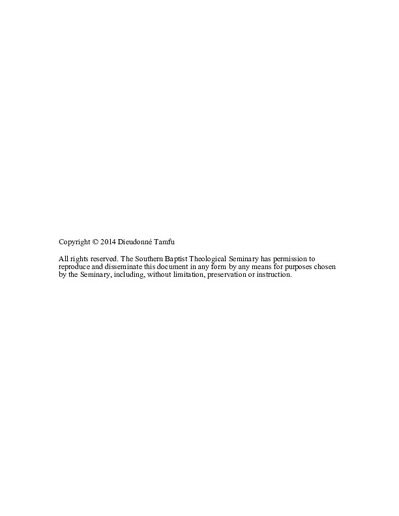| dc.contributor.advisor | Hamilton, James M. | |
| dc.contributor.author | Tamfu, Dieudonne | |
| dc.date.accessioned | 2015-03-31T13:49:24Z | |
| dc.date.available | 2015-03-31T13:49:24Z | |
| dc.date.issued | 2015-03-31 | |
| dc.identifier.uri | http://hdl.handle.net/10392/4860 | |
| dc.description.abstract | This dissertation examines the use of water imagery in the book of Psalms and argues that the psalmists primarily employed this imagery to allude to four accounts of God's works in the Pentateuch--the waters of creation, the water in the Garden of Eden, the flood, and the crossing of the Red Sea--as paradigms for understanding their present and the future.
Each chapter examines the use of the water motif in a particular book of the Psalms. In each chapter I attempt to prove, through verbal and thematic links, that the authors of the Psalms were biblical theologians in that the Pentateuch shaped their worldview. Because of their scripture-shaped worldview, they employed water imagery from earlier scriptures to interpret present-day events.
The psalmists' use of water imagery also pointed to the future. Through water imagery they alluded to the Garden of Eden to express hope for a new future Eden. For the psalmists the creation of the world was a model of how God would one day remake creation. The flood and the crossing of the Red Sea are also paradigmatic events that guided the psalmists' understanding of God's work of salvation and judgment in the present and the future. The psalmists' hope for a future of divine salvation and judgment took its design from the flood and the Red Sea. | en_US |
| dc.subject.lcsh | Bible. Psalms--Criticism, interpretation, etc. | en_US |
| dc.subject.lcsh | Water in the Bible | en_US |
| dc.title | The Water Imagery in the Psalms: An Inner-Biblical Interpretation | en_US |
| dc.type | Electronic dissertation | en_US |
| dc.type | Text | en_US |
| dc.publisher.institution | Southern Baptist Theological Seminary | en_US |

